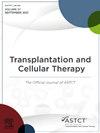High Amphiregulin Expression in Intestinal Biopsies of Pediatric Patients with Severe Acute Graft-Versus-Host Disease
IF 3.6
3区 医学
Q2 HEMATOLOGY
引用次数: 0
Abstract
Acute graft-versus-host disease (GvHD) is a major complication of hematopoietic cell transplantation (HCT). Despite of recent advances in prophylaxis, diagnosis and treatment it is still a serious cause of morbidity and mortality after HCT. Amphiregulin (AREG) is an epidermal growth factor receptor ligand known for restoring damaged intestinal tissue. AREG has been studied as a blood biomarker in acute GvHD and was found predictive of steroid response and mortality. However, the expression of AREG in intestinal tissue in pediatric patients with acute GvHD is unknown. The aim of this study is to analyze and evaluate AREG expression in intestinal tissue biopsies of pediatric patients with GvHD, in comparison to patients with inflammatory bowel disease (IBD) and a control group with no pathological findings to provide insights in the biological tissue expression of this potential diagnostic and prognostic biomarker. We performed a retrospective study with pediatric patients who had an intestinal biopsy performed after HCT between 2010 and 2021, patients who had a diagnosis of IBD and patients with normal findings at the University Children's Hospital Zurich. Intestinal biopsies were stained for AREG. We used a semi-quantitative score ranging from 0 (not present) to 3 (intense) to grade the AREG expression. The grading was performed by a pathologist blinded to the group allocation. Lerner scores were also performed. The median AREG scores between the groups were compared using multivariable linear regression with age and sex as confounders. The study protocol was approved by the Ethical committee of Canton Zürich, Switzerland, number 2022-01037. Overall, 59 biopsies were stained for AREG, 20 after HCT (6 patients with severe GvHD, 5 with mild GvHD and 9 without GvHD), 19 with IBD and 20 controls. The median for the AREG overall grade for control group was 2, for the HCT with severe GvHD group 2.5 (P = .060) and for the IBD group 2.5 (P = .007). The results for the AREG epithelium and lamina propria grades were similar. There were no differences in survival between patients with GvHD with overall AREG scores below and greater or equal to the median of 2.5. This study showed that AREG scores were higher in intestinal biopsies from patients with severe GvHD and IBD compared to controls and patients with mild or no GvHD. Consequently, AREG staining could potentially be used as an additional marker for severe inflammation as seen in GvHD and IBD.
双调节蛋白在严重急性移植物抗宿主病患儿肠道活检中的高表达
急性移植物抗宿主病(GvHD)是造血细胞移植(HCT)的主要并发症。尽管最近在预防、诊断和治疗方面取得了进展,但它仍然是HCT后发病和死亡的一个严重原因。双调节蛋白(AREG)是一种表皮生长因子受体配体,具有修复受损肠道组织的作用。AREG已被研究作为急性GvHD的血液生物标志物,并被发现可预测类固醇反应和死亡率。然而,急性GvHD患儿肠组织中AREG的表达尚不清楚。目的:本研究的目的是分析和评估小儿GvHD患者肠道组织活检中AREG的表达,并与炎症性肠病(IBD)患者和无病理结果的对照组进行比较,以深入了解这一潜在诊断和预后生物标志物的生物组织表达。方法:我们对2010年至2021年间在苏黎世大学儿童医院接受HCT后进行肠道活检的儿童患者、诊断为IBD的患者和检查结果正常的患者进行了回顾性研究。肠活检进行AREG染色。我们使用半定量评分,范围从0(不存在)到3(强烈)对AREG表达进行分级。分级由一名不知道分组分配情况的病理学家进行。同时进行勒纳评分。以年龄和性别为混杂因素,采用多变量线性回归比较各组间AREG评分中位数。研究方案已获瑞士Canton zrich伦理委员会批准,编号2022-01037。结果:总体而言,59例活检组织进行了AREG染色,20例HCT后进行了AREG染色(6例重度GvHD, 5例轻度GvHD, 9例无GvHD), 19例IBD, 20例对照组。对照组AREG总评分中位数为2,HCT合并严重GvHD组为2.5 (p = 0.060),IBD组为2.5 (p = 0.007)。AREG上皮和固有层分级的结果相似。总体AREG评分低于或大于或等于中位数2.5的GvHD患者的生存期没有差异。结论:本研究表明,与对照组和轻度或无GvHD患者相比,严重GvHD和IBD患者的肠道活检中AREG评分更高。因此,AREG染色有可能作为GvHD和IBD严重炎症的额外标记物。
本文章由计算机程序翻译,如有差异,请以英文原文为准。
求助全文
约1分钟内获得全文
求助全文
来源期刊

Transplantation and Cellular Therapy
Medicine-Hematology
CiteScore
7.00
自引率
15.60%
发文量
1061
审稿时长
51 days
 求助内容:
求助内容: 应助结果提醒方式:
应助结果提醒方式:


